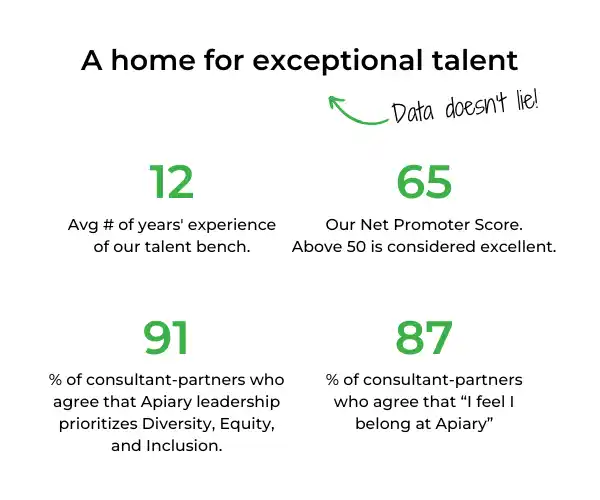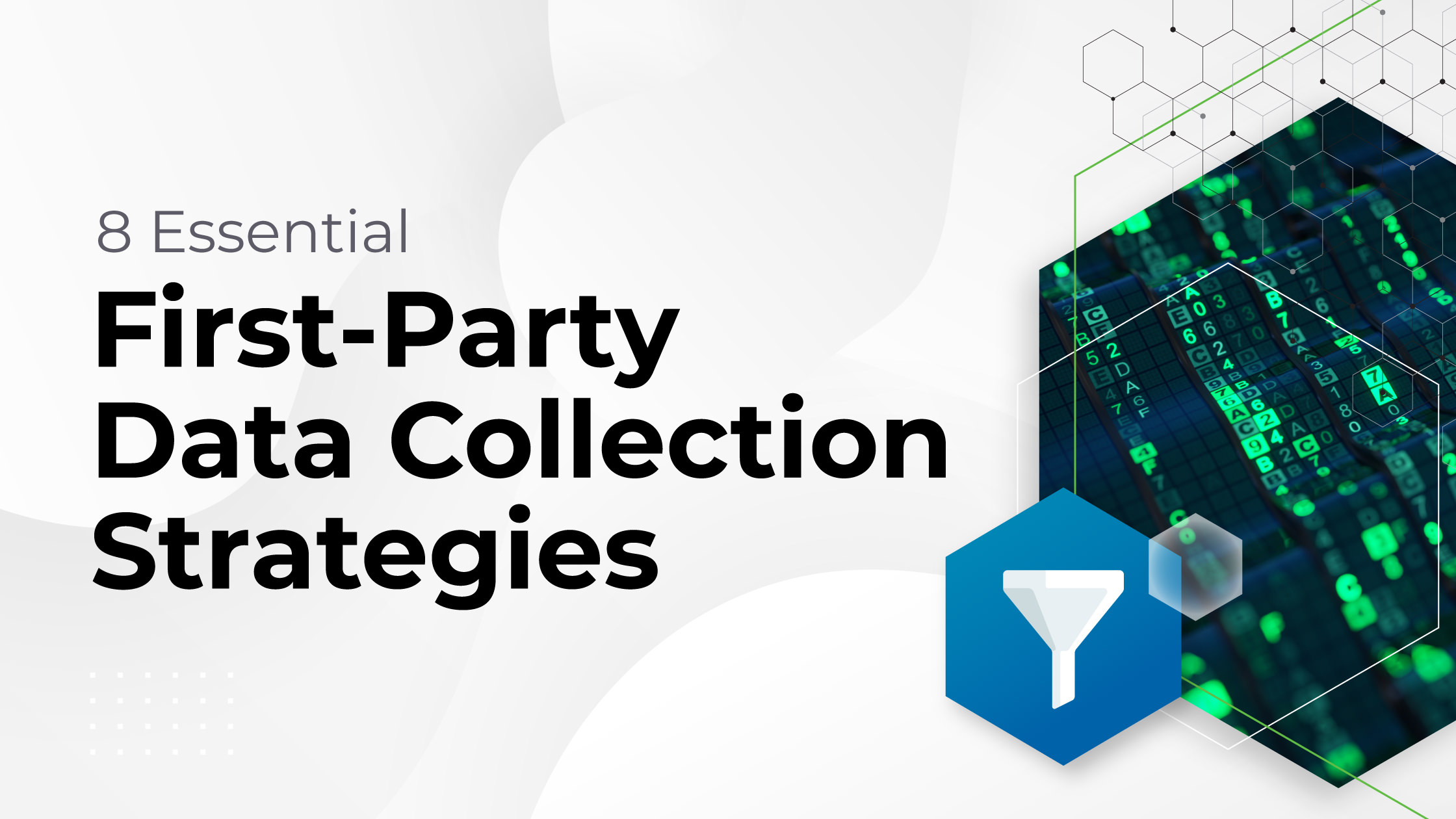
Odds are good that your favorite business news source is overflowing with shade for the gig economy and hybrid work.
“Companies need a center of gravity!”
“Collaborating in a physical office space is vital!”
Or, our favorite: “No one wants to work anymore!”
We’ve noticed that the terms ‘gig work’ and ‘hybrid work’ are increasingly used interchangeably but they’re actually not the same thing. And while Apiary does appreciate aspects of the gig economy and aspects of hybrid work, we’ve intentionally been neither since we launched in 2014.
What’s undeniable is that the future of work is indeed changing, and brands committed to longevity need to be well-informed about the expectations and options available inside this evolving talent market.
For a clearer understanding of all the terms being thrown around right now, and for our unique perspective as an organization that’s mixed a little bit of gig with a little bit of hybrid, today’s Apiary POV will explore:
- What is the gig economy?
- What are some gig economy examples?
- What are the benefits of the gig economy?
- What are the downsides of the gig economy?
- What is hybrid work? And how is it different from gig work?
- What are the benefits of hybrid work?
- What are some hybrid work model examples?
- Does Apiary practice a gig or hybrid model? (Preview: Neither!)
What is the gig economy?
The gig economy is a plug-n-play labor market oriented around temporary contracts and freelance jobs filled by independent contractors instead of full time, permanent employees.
The term was originally borrowed from the music world where performers often refer to one-time-only events or short-term bookings as “gigs”.
Fans of gig economies claim that this kind of work system produces cheaper and more efficient services. We’d like to respectfully debate this distinction, but more on that soon.
What are some gig economy examples?
Since the 2010s, gig economy jobs have often been synonymous with digital platforms that offer ride sharing, food and grocery delivery, or personal convenience services, like Uber, DoorDash, Instacart, and TaskRabbit. In this sector of gig work, concerns have been flagged regarding low pay and poor working conditions.
However, there’s also an active gig economy over here in the digital marketing hemisphere, which is where we’d like to focus our exploration.
Operating through LinkedIn, or other job sites like Indeed, Upwork, Fiverr, or 99designs, marketing gig workers provide professional services across a range of specialties, including:
- Technical SEO
- Marketing analytics and reporting
- B2B lead generation
- eCommerce marketing
- PPC advertising, and more.
What are the benefits of the gig economy?
We should state up front that Apiary has big reservations about certain aspects of the gig economy, which we’ll get to in a moment. First, let’s establish what the gig economy offers and why it’s attractive to so many.
For gig workers, the most commonly cited benefits are:
- Autonomy to self-select working vs non-working hours
- Remote work and/or work location flexibility
- Evolving door of short-term contracts supports project and team diversity.
For employers, the primary benefits of hiring gig workers are:
- No legal requirement to cover benefits like health insurance or PTO
- Access to specialized skills that aren’t needed year-round, at a fraction of the cost of a permanent employee
- Ability to scale your workforce up/down on demand.
So if the gig economy is changing the workforce to offer all these benefits to both workers and employers, why on earth isn’t Apiary singing its praises?
There are certainly many people who currently make their full-time living through gig work and would say they’re fulfilled by the nature of the work, team dynamics, and compensation. It’s also true that the gig economy has provided a pathway to economic advancement for community segments that have faced entrenched resistance in traditional, corporate employment. We celebrate these factors and don’t at all deny that the gig economy works for some people.
Our concern is that with just a slight tip of a few factors, a pure gig economy does NOT consistently support successful outcomes for many workers or brands. Here’s why:
Downsides of the gig economy
#1. Gig work is often not expert work.
In a gig economy, speed and reduced costs are the name of the game. While many brands would list these factors as strong advantages, it’s important to examine exactly what kind of worker is available and willing to work under these conditions.
Typically, gigs offering lower pay while expecting tight (bordering on unreasonable) turnaround times do not attract seniors who are subject matter experts in their particular niche.
So can you find a graphic designer or SEO consultant who’s willing to work in a gig dynamic? Of course. Is it likely that they’re an established expert in their field, with a proven track record of generating results for brands like yours? In our opinion, it’s not.
The claim that the gig economy produces cheaper services is based solely on the hourly rate x total hours on a project, but doesn’t consider the greater cost to the business down the road when low quality work has to be redone.
#2. Short-term efficiencies override long-term growth implications.
Working in the gig economy typically requires putting blinders on in the interest of focusing on a single problem. On one hand, focus! We love focus. But it could equally be said that those blinders are doing what their name says: blinding you.
Tapping an expert to solve one explicit problem is undoubtedly a short-term benefit of gig work, but the compounding effect of this single-solution approach is that business decisions are increasingly being made in silos with all eyes looking down at a single spot in a single moment.
Sustainable growth requires short-term decisions that align with the long-term health of the entire business ecosystem. This requires deep analysis of the present moment AND consideration of future, projected moments.
Many gig solutions are born from a fixation on the next 5 minutes, and miss the opportunity to make thoughtful and calculated decisions that contribute to true business longevity.
#3. The well-being of the human folk!
Despite the flexibility and independence advantages mentioned above, gig workers receive exponentially fewer state and federal protections and a lack of benefits.
Furthermore, many gig contracts expect high volume deliverables with steep timelines that make it difficult for workers to maintain family commitments or tend to their own mental, emotional, and physical health while engaged on that project. This not only diminishes the overall well-being of gig workers (leading to a host of social issues), but also reduces the quality of performance outputs they’re able to offer the brands they’re working for.
The gig economy trades creativity, long-term growth, and talent’s well-being for speed and reduced costs. For businesses interested in sustainability and workers who want to live well, that’s a bad trade.

What is hybrid work? And how is it different from gig work?
Think back to the ancient days called the 1990s. Office culture was not just the standard for most professional services providers – it was ubiquitous.
Work was a full-time endeavor. Cubicles were the norm, unless you were gunning for an office-with-a-door promotion. And grab those Friday morning doughnuts before they’re…
Hybrid work environments iterate on that version of office life by giving employees the option to flex between in-office and remote work.
Unlike the gig economy, hybrid workers are typically long-term employees (mostly full-time) who are now leveraging technology to fulfill their work commitments whether they’re physically in the office or not.
This is the key distinction between hybrid work and gig work.
- Hybrid workers are salaried employees who agree to an extended (often, indefinite) period of employment that includes federal and state required protections and benefits.
- Gig workers are independent contractors who agree to a finite period of work, with no paid benefits and far fewer legal protections. They may or may not be fully or partially remote workers.
What are the benefits of hybrid work?
Brands of all sizes are looking for performance improvements, which puts attracting and retaining top talent and then empowering them to grow the bottom line, at the top of the priority list.
For brands, this is the main benefit of hybrid work. Multiple surveys show that a significant segment of the talent market continues to resist the post-pandemic expectation that they’ll return to the office. Instead, talent is attracted to fully remote and hybrid jobs because they offer:
- Improved work-life balance
- Higher productivity and time management efficiencies
- Greater control over work hours and work location
- Reduced rates of burnout
What are some hybrid work model examples?
It’s important to note that hybrid work can exist in a top-down structure (leadership dictates the percentage of time that employees can work remotely vs in the office) or a bottom-up model (individuals set their own work hours and location). Not all hybrids are created equal.
Apiary isn’t shy about our bias toward a talent-driven work structure, which is why we celebrate companies like credit card processor, Gravity Payments, who offer employees complete freedom to choose between remote, on-site, or hybrid work.
Similarly, Hubspot’s Hybrid Culture Principles have constructed a hybrid workplace that gives employees three options to choose from:
- Home – Working almost exclusively from home, these employees can come to the office once or twice per quarter, maximum.
- Office – Working on-site 3 or more times per week, these employees are the only category that has a dedicated desk on site.
- Flex – The true hybrid option. This is for employees who come to the office 2 or fewer days per week.

A note on leaders screaming that remote/hybrid work cannot be successful:
The brands mentioned above, and certainly our own Apiary work model, prove that repeatable business success is absolutely possible within a hybrid or fully remote environment.
So what are brands who are struggling to go hybrid/remote missing?
1. Look at your tech stack.
- Did you build a strategic stack of technological tools and environments that support collaboration without requiring people to be in physical proximity?
- Did you survey your team for feedback on how that first set of tools worked or didn’t?
- Did you act on that survey feedback to iterate your tech stack?
And that brings us to the internal communications that either hold everything up or set you up to crumble…
2. Look at your internal communications and culture commitments.
- How was the interconnectedness of each piece of the tech stack rolled out, and introduced during the onboarding process?
- What campaigns and ongoing content pieces are intentionally driving team ethos?
- How are your HR, marketing and communications teams aligning as ONE unit to ensure employee health is the highest of priority?
- How is leadership modeling and facilitating community building and a team culture that isn’t reliant on sharing physical space?
Fully remote or hybrid work models can be incredibly successful for talented humans who aspire to a life that doesn’t revolve around work, and for brands looking to get the best out of their talent.
Does Apiary practice hybrid work or gig work?
Neither. As our CEO likes to say, “Apiary is the new way of work. But for us, it’s old.”
We are a 100% remote collective of senior digital marketing contractors. Headquartered in the cloud from day one. Office wars have never been our battle.
Our model pairs client-partners with a highly curated team of independent consultant-partners selected for their ability to drive performance.
Consultant-partners are invited (never assigned) to projects and our only ask is that they’re reachable at least 4 business hours per day. Which 4 hours? That’s up to them.
Unlike conventional gig contracts, Apiary streamlines the independent contractor experience by assuming full responsibility for:
- Sourcing, pitching, and securing client-partner relationships
- All administrative requirements, including contracts, invoicing client-partners and disbursing consultant-partners payments, ALWAYS on time
- Access to all marketing tech stack programs/software that consultant-partners need to deliver client-partner results
- Liability insurance and data privacy protection coverage.

We do overlap a bit with the gig economy because our consultant-partners are not full-time employees, but unlike the gig economy, we only retain senior experts, each with an average of 12 years’ experience.
And hybrid is, by definition, a mixture of remote and office work. Apiary has never had a physical office or any officially organized in-person company meetups.
We’ll forever be based in the cloud because this best facilitates our #1 goal as an organization:
Give humans the opportunity to decide when and where they work and what their output needs to be, in collaborative consideration with their non-work priorities.
This makes the work better.
This makes the relationships better.
This makes humans better, and humans are always greater than business.
(And ta-da! Whenever humans thrive, so does business performance.)
TL;DR summary
- In a gig economy, people work in temporary positions as independent contractors. Proponents celebrate this work model for producing cheaper, more efficient services.
- The often unacknowledged downsides of a gig economy include:
- Senior experts are often unattracted to this model
- Work produced by less experienced service providers has to be redone, which negates the ‘cheaper’ claim associated with the gig economy
- Gig work that targets a single issue can miss the broader insights and resource investments needed to drive long-term business success.
- Senior experts are often unattracted to this model
- Hybrid work refers to a combination of in-person and remote work options.
- Hybrid work can function as a top-down model that assigns a ratio of remote: office time, or a bottom-up model that lets workers choose whether they’d prefer to be fully remote employees or fully/partially in an office.
- Apiary is not a hybrid model because we’re 100% remote. No offices ever.




